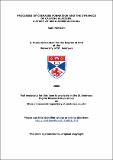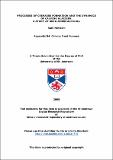Files in this item
Processes of crevasse formation and the dynamics of calving glaciers : a study at Breiđamerkurjökull
Item metadata
| dc.contributor.advisor | Benn, Douglas I. | |
| dc.contributor.author | Mottram, Ruth | |
| dc.coverage.spatial | xxii, 330 p. | en |
| dc.date.accessioned | 2009-11-09T15:26:21Z | |
| dc.date.available | 2009-11-09T15:26:21Z | |
| dc.date.issued | 2008 | |
| dc.identifier.uri | https://hdl.handle.net/10023/775 | |
| dc.description.abstract | A new model proposed by Benn et al. (2006, 2007) explains the dynamics of calving glaciers based on a new sliding law and a calving criterion modified from a crevasse depth model. In this thesis three key elements of this model are tested: 1) the role of longitudinal stretching as a result of velocity gradients, which pre-conditions ice at the glacier terminus for calving failure; 2) the accurate prediction of crevasse depths from strain rates, for inclusion within a calving model as a calving criterion; 3) the role of dynamically induced thinning (as a result of longitudinal stretching at an accelerating glacier) in causing further acceleration and calving retreat and the onset of a dynamic thinning feedback through reduced basal pressure. Field results show that longitudinal strain rates are important controls on calving glaciers, controlling both dynamic thinning and crevasse depths. Crevasse-depth models proposed by Van der Veen (1998a, 1998b) and Nye (1957) work well in predicting crevasse depths based on measured strain rates. The latter in particular is suitable for inclusion as a calving criterion when modified with a yield criterion. The importance of water in enhancing propagation of crevasses is demonstrated through modelling studies, and is implicitly included in the calving model. Measured rates of dynamic thinning at Breiðamerkurjökull, a glacier in South East Iceland, confirm the importance of this process within a calving model and results from a simple 1-D model show that the new sliding law not only predicts velocities effectively, but can also predict the position of a calving terminus based on strain rates and the calving criterion. Suggestions are made for further more detailed modelling, including time evolution and longitudinal stress gradients, to apply the model to a range of glaciers and to predict the response of calving glaciers to climatic and environmental changes. | en |
| dc.language.iso | en | en |
| dc.publisher | University of St Andrews | |
| dc.title | Processes of crevasse formation and the dynamics of calving glaciers : a study at Breiđamerkurjökull | en |
| dc.type | Thesis | en |
| dc.type.qualificationlevel | Doctoral | en |
| dc.type.qualificationname | PhD Doctor of Philosophy | en |
| dc.publisher.institution | The University of St Andrews | en |
This item appears in the following Collection(s)
Items in the St Andrews Research Repository are protected by copyright, with all rights reserved, unless otherwise indicated.


